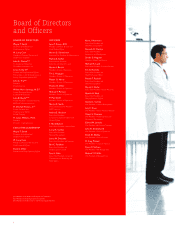Community Health Systems 2015 Annual Report Download - page 19
Download and view the complete annual report
Please find page 19 of the 2015 Community Health Systems annual report below. You can navigate through the pages in the report by either clicking on the pages listed below, or by using the keyword search tool below to find specific information within the annual report.• discharge planning, and
• compliance with all regulatory standards.
Our case management program integrates the functions of utilization review, discharge planning, assessment
of medical necessity and resource management. Patients are assessed upon presentation to the hospital and
throughout their course of care with ongoing reviews. Industry standard criteria are utilized in patient
assessments, and discharge plans are adjusted according to patient needs. Cases are monitored to prevent delays
in service or unnecessary utilization of resources. When a patient is ready for discharge, a case manager works
with the patient’s attending physician to evaluate and coordinate the patient’s needs for continued care in the
post-acute setting. Each hospital has the support of a physician advisor to act as a liaison to the medical staff and
assist with all the activities of the program.
Improve Patient Safety and Quality of Care
Each of our hospitals is operated by a corporate board of directors that has established a local board of trustees,
which includes members of the hospital’s medical staff. The board of directors delegates certain matters to the
board of trustees, including establishing policies concerning the hospital’s medical, professional, and ethical
practices, monitoring these practices, and responsibility for ensuring that these practices conform to legally
required standards. We maintain quality assurance programs to support and monitor quality of care standards and
to meet Medicare and Medicaid accreditation and regulatory requirements. Patient care evaluations and other
quality of care assessment activities are reviewed and monitored continuously with comparison to regional and
national benchmarks when available.
We believe value-based purchasing models, such as linking payment for healthcare services to performance on
objective measures, will increasingly become key drivers of financial performance. We have implemented various
programs to support our hospitals in an effort to ensure continuous improvement in patient safety and the quality of
care provided. We have developed high reliability/safety and quality training programs for all senior hospital
management, chief nursing officers, quality directors, physicians and other clinical staff. We share information
among our hospital management to implement best practices and assist in complying with regulatory requirements.
We have standardized many of our processes for documenting compliance with accreditation requirements and
clinical practices proven to lead to improved patient outcomes. All hospitals conduct patient, physician and staff
satisfaction surveys to help identify methods of improving patient safety and the quality of care.
To ensure the experience of our emergency room patients meets our service and quality expectations, we have
implemented a program to contact selected patients as a follow-up to the services they received. We verify that
patients were able to obtain any prescriptions and outpatient appointments recommended at discharge. We also
ensure that their symptoms have abated and that they understood the discharge instructions given at the hospital.
Through this program, we placed almost two million follow-up calls in 2015.
In 2011, we established a component patient safety organization, or PSO, which was listed by the U.S.
Department of Health and Human Services Agency for Healthcare Research and Quality on January 11, 2012.
We believe our PSO has assisted, and will continue to assist, us in improving patient safety at our hospitals. The
PSO was recertified in 2014 through 2018.
Grow Through Selective Acquisitions
Acquisition Criteria. Acquisitions have been a core part of our growth strategy historically. We intend to
maintain a disciplined and targeted approach to acquisitions and seek opportunities that are complementary to
our existing markets or represent new markets that fit our operating criteria. Generally, we pursue acquisition
candidates that:
• are located in a market that has a stable or growing population base,
• are the sole or primary provider of acute care services in the community,
6
























